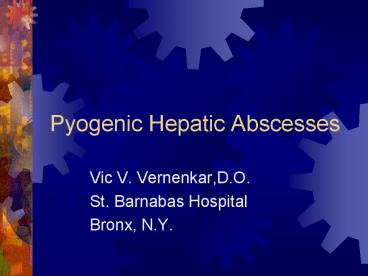Pyogenic Hepatic Abscesses - PowerPoint PPT Presentation
1 / 25
Title:
Pyogenic Hepatic Abscesses
Description:
In 1883 Koch described the amoeba as a cause of liver abscess. ... Appendicitis, diverticulitis, IBD, proctitis. Etiology. Hematogenous. Via hepatic artery. ... – PowerPoint PPT presentation
Number of Views:3952
Avg rating:5.0/5.0
Title: Pyogenic Hepatic Abscesses
1
Pyogenic Hepatic Abscesses
- Vic V. Vernenkar,D.O.
- St. Barnabas Hospital
- Bronx, N.Y.
2
Introduction
- Described since age of Hippocrates
- In 1883 Koch described the amoeba as a cause of
liver abscess. - In 1938 Debakey published largest series in the
lierature. - Over last 2 decades,percutaneous drainage has
becaome a therapeutic option.
3
Frequency
- Uncommon, prevalence in autopsy series
0.29-1.47. - Incidence in the US is 8-15 per 100,000.
- Male to female ratio is 21 in recent studies.
- 4th-6th decades of life.
4
Etiology
- Biliary disease accounts for 21-30, with
extrahepatic obstruction leading to ascending
cholangitis and abscess. Also CBD stones, benign
and malignant tumors, biliary enteric anastamoses.
5
Etiology
- Infection via portal system
- Infectious process originates in abdomen, reaches
liver by embolization of portal system. - Appendicitis, diverticulitis, IBD, proctitis
6
Etiology
- Hematogenous.
- Via hepatic artery.
- From systemic septicemia.
- No cause in 50 of cases, but increased in
diabetics and metastatic cancer.
7
Pathophysiology
- Access to liver by direct extension from nearby
organs. - Through portal vein and hepatic artery.
- Hepatic clearance of bacteria via portal system
is a normal phenomena, but organism
proliferation, tissue invasion and abscess can
occur with biliary obstruction, poor perfusion,
microembolization.
8
Microbiology
- Most contain more than one organism, with source
biliary or enteric. - Blood cultures positive in 33-65.
- E.Coli 33.
- Klebsiella 18.
- Bacteroides 24.
- Streptococcal 37.
9
Clinical
- Fever, right upper quadrant pain (80).
- Right shoulder pain, pleuritic chest pain.
- Fever 87-100.
- Anorexia, weight loss, mental confusion.
- Physical exam shows RUQ tenderness, hepatomegaly,
liver mass, jaundice.
10
Indications For Open Drainage
- Abscess not amenable to percutaneous drainage
- Co-existing intra-abdominal disease that requires
operative management. - Failure of antibiotic therapy.
- Failure of percutaneous aspiration or drainage.
11
Relative Contraindications
- Age older than 70.
- Multiple abscesses.
- Polymicrobial infection.
- Presence of associated malignancy or
immunosupressive disease. - Multiple medical problems.
12
Workup
- Lab studies include CBC anemia in 50-80,
leukocytosis in 75-96. - LFTs elevated alkaline phosphatase 95-100,
elevated AST, ALT 40-60. - Elevated bilirubin in 28-73.
- Decreased albumin in 71-87.
13
Imaging Studies
- Chest film abnormal in 50.
- Abdominal film can show intrahepatic air,
air-fluid levels, pneumobilia. - Ultrasound 80-100 sensitive, round hypoechoic
mass consistent with abscess. - CT scan is study of choice, abscesses are non
enhancing with contrast.
14
Medical Therapy
- Most dramatic change has been CT guided
percutaneous drainage. - Previously, open surgical procedures had a
mortality rate as high as 70. - Current approach has three steps.
15
Medical Therapy
- Initiation of antibiotic therapy.
- Diagnostic aspiration and drainage of abscess.
- Surgical drainage in selected patients.
16
Antibiotic Therapy
- Diagnostic aspiration should be employed prior to
antibiotic therapy. - Coverage should include aerobic gram negatives,
streptococcus, anerobic, including bacteroides. - Flagyl and clindamycin is usually good.
17
Percutaneous Drainage
- CT or US guided placement of a catheter.
- Drain is removed once abscess cavity collapses.
- Success 80-87.
- Consider open drainage if fails, or patient
worsens over 72 hrs.
18
Complications of Percutaneous Drainage
- Perforation of a viscous.
- Pneumothorax.
- Bleeding.
- Leakage of pus into the abdomen.
- Immunocompromised patients with multiple
abscesses are best treated with high dose
antibiotics rather than open or percutaneous
drainage.
19
Surgical Therapy
- Five indications as previously discussed.
- Presence of peritoneal signs mandates emergent
exploration. - Transthoracic, extraperitoneal, transperitoneal.
- Transperitoneal is preferred as intra-abdominal
pathology can be dealt with.
20
Complications
- Result from rupture of abscess into adjacent
organs or cavities. These include both
pleuropulmonary and intrabdominal types. - Pleuropulmonary are themost common 15-20,
include effusions, empyema, bronch-hepatic
fistula. - Intraabdominal include subphrenic abscess,
rupture into peritoneal cavity, stomach, colon,
vena cava, or kidney.
21
Outcome andPrognosis
- Untreated, pyogenic abscess has a 100 mortality
rate. - Now with early drainage and antibiotics,
mortality ranges 15-20. - The four poor prognostic factors are, age over
70, multiple abscesses, polymicrobial infection,
presence of associated malignancy or
immunosupression.
22
(No Transcript)
23
(No Transcript)
24
(No Transcript)
25
(No Transcript)































